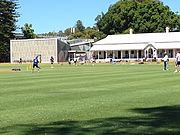Sport Informatics and Analytics/Audiences and Messages
Contents
Overview
Theme 4 of this course looks at how we share the insights we gain from sport informatics and analytics processes. It invites you to reflect on the why? what? how? and when? of sharing messages with different types of audience.[1][2]
This theme:
- Discusses augmented information in general and feedforward in particular.
- Explores the visualisation of data.
- Considers personal learning environments, ePortfolios and reflection.
In addition to this introduction, this theme contains these topics:
Augmented information
Karl Newell and his colleagues' (1985)[3], in the introduction to their discussion of augmented information and skill acquisition in physical activity, observe:
Skilled performance in any physical activity is usually the reflection of many hours of practice by the performer in that action. Practice does not merely involve repeated engagements in an activity but often interactions between the performer and an advisor... The central thrust of these interactions ... is the conveyance of information.[4]
They add "the conveyance to the performer of any information not naturally available within the task constraints can usefully be construed as augmented".[5]
Your role as a sports analyst involves you in decisions about the provision of augmented information to coaches, athletes and other support staff. These decisions offer you opportunities to reflect on how you communicate.
Claude Shannon (1949)[6] proposed that a communication system has five parts:
- An information source
- A transmitter
- A channel
- A receiver
- A destination
Chelsea Ursaner summarises this system:
The message starts from a source, such as a human or a machine. It gets expressed via a transmitter, such as a letter or a tweet or your vocal chords. It then travels over a channel, like airwaves, where it is subject to noise. It hits a receiver, like someone’s mailbox or twitter feed. Lastly, it arrives (or maybe doesn’t) at a destination, such as someone’s brain.[7]
Harold Lasswell[8] suggested that a "convenient way to describe an act of communication is to answer the following questions":
- Who
- Says what
- In which channel
- To whom
- With what effect?[9]
He adds "In gauging the efficiency of communication in any given context, it is necessary to take into account the values at stake, and the identity of the group whose position is being examined".[10]
In sport contexts, this may involve you in considerations about the feedback or the feedforward you provide. This includes, as Richard Schmidt[11] argued, the frequency of the augmented information you share.
We hope that this course will encourage you to reflect on the mindfulness you will develop as you extend your experiences of observing, analysing and sharing accounts of performance in sport.
Sharing Insights
Video signpost
In this video, Carrie Graf, former coach of the University of Canberra Capitals, and a University of Canberra Coach in Residence in 2015, discusses how she shares information with the teams she coaches.
Resources
- A Theme overview.
- A slide presentation.
- A mind map that includes resources up to 2015. For more recent resources, 2016 onward, see this site.
- Course wiki links audiences and messages and visualisations.
- Video suggestions. (See slides 9-13.)
- There are some additional resources.
ePortfolio questions
References
- ↑ Saxena, Amena (28 June 2018). "The Design of Statistical Graphics". https://towardsdatascience.com/the-design-of-statistical-graphics-5265485e9bb5. Retrieved 1 July 2019.
- ↑ Peng, Roger (18 January 2019). "The Tentpoles of Data Science". https://simplystatistics.org/2019/01/18/the-tentpoles-of-data-science/. Retrieved 20 July 2019.
- ↑ Newell, K; Moris, L; Scully, D (1985). "Augmented information and the acquisition of skill in physical activity". Exercise and sport sciences reviews 13(1) (1): 235-262.
- ↑ Newell, K; Moris, L; Scully, D (1985). "Augmented information and the acquisition of skill in physical activity". Exercise and sport sciences reviews 13(1) (1): 235.
- ↑ Newell, K; Moris, L; Scully, D (1985). "Augmented information and the acquisition of skill in physical activity". Exercise and sport sciences reviews 13(1) (1): 235.
- ↑ Shannon, Claude (2001). "A mathematical theory of communication". ACM SIGMOBILE Mobile Computing and Communications Review 5(1): 3-55.
- ↑ Ursaner, Chelsea (17 November 2017). https://medium.com/aint-nobody-got-time-for-that/information-theory-f3b11050a3ae. Retrieved 22 November 2017.
- ↑ Lasswell, Harold (1948). "The structure and function of communication in society". The communication of ideas 37 (1): 215-228.
- ↑ Lasswell, Harold (1948). "The structure and function of communication in society". The communication of ideas 37 (1): 216.
- ↑ Lasswell, Harold (1948). "The structure and function of communication in society". The communication of ideas 37 (1): 228.
- ↑ Schmidt, Richard (1991). "Frequent augmented feedback can degrade learning: Evidence and interpretations". Tutorials in motor neuroscience: 59-75.
- ↑ Buchheit, Martin. "Houston, will still have a problem". https://martin-buchheit.net/2017/07/03/houston-we-still-have-a-problem/. Retrieved 17 November 2017.
- ↑ Buchheit, Martin. "Houston, will still have a problem". https://martin-buchheit.net/2017/07/03/houston-we-still-have-a-problem/. Retrieved 17 November 2017.
- ↑ Tran, Jacquie. "From insights to decisions: Knowledge sharing in sports analytics". https://www.slideshare.net/jacquietran/from-insights-to-decisions-knowledge-sharing-in-sports-analytics. Retrieved 24 November 2018.
- ↑ Nickel, Lori (11 February 2018). "Bucks are eager to get ahead of the game with analytics". https://www.jsonline.com/story/sports/nba/bucks/2018/02/11/bucks-eager-get-ahead-game-analytics/324896002/. Retrieved 15 February 2018.


